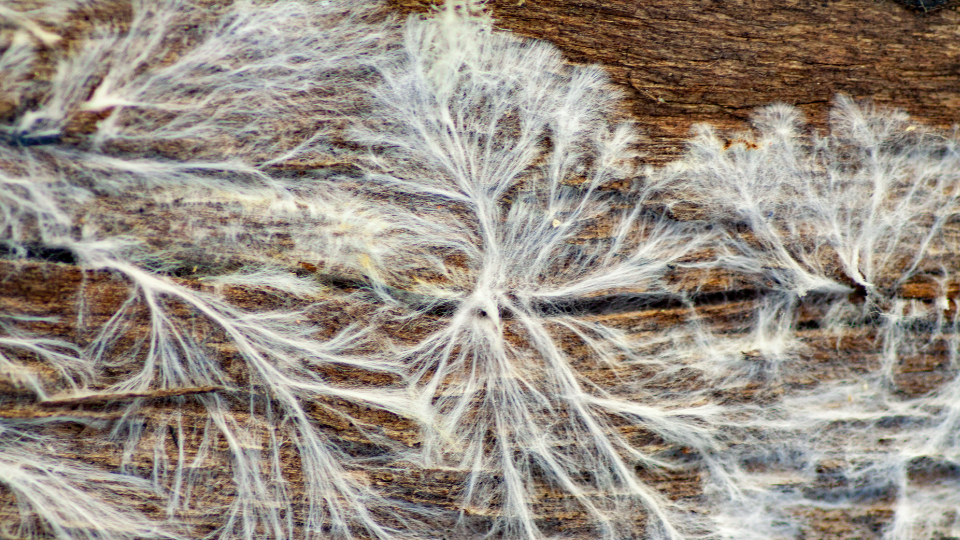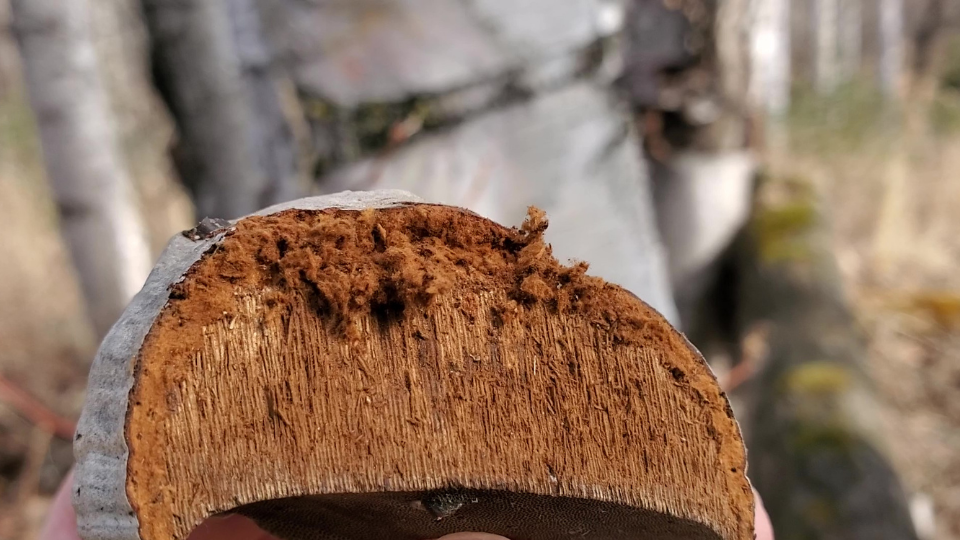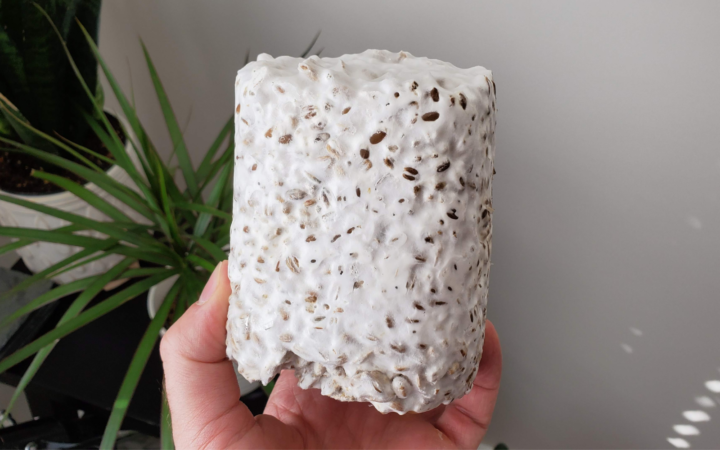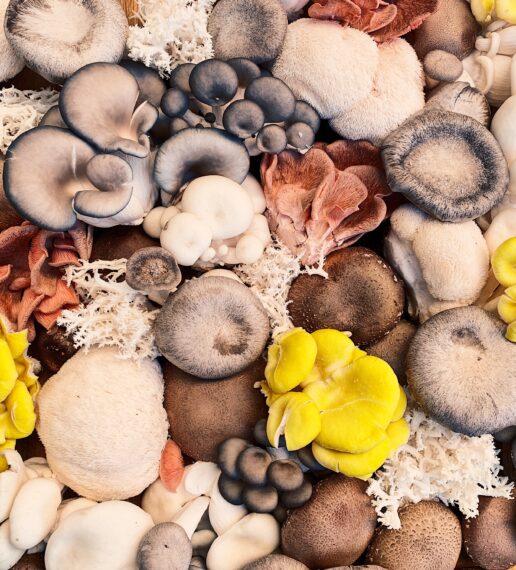How Mushrooms Can Be Made Into Packaging, Leather, and Even Bacon
Have you heard of mushroom leather?
How about mushroom “Styrofoam,” bricks—and even coffins?
It’s not science fiction. Mushrooms are incredibly versatile, and innovative minds are starting to explore the amazing potential of fungi to replace common materials used in clothes, packaging and buildings.
The secret lies in the special properties of mycelium.
Meet the Mycelium

What is mycelium?
In nature, it’s the network of fibers that stealthily spreads out of sight beneath the soil. You’d never know it was there if not for the fruiting bodies that pop up when conditions are right.
And fruiting bodies are only the tip of the iceberg.
Mycelial fibers are made largely of chitin, cellulose, proteins and other polymers[1] and can form networks that stretch for miles, feeding on wood, plant waste and even microbes. Filaments called hyphae extend from the mycelium and take up nutrients from these sources to support the entire fungal mass.
Hyphae are also responsible for the binding properties that make mycelium an attractive building block for mushroom materials. As mycelium grows, the fibers weave together to create large “mats,” a process that can be harnessed to create all kinds of products.
Benefits of Mycelium Materials
Why replace things like leather and plastic with alternatives made from mycelium? A lot of the materials we take for granted aren’t very efficient can damage the environment.
Mycelium might not be an immediate practical solution (there’s a lot of development still to be done!), but creative entrepreneurs are exploring some of the potential impacts of using fungi-based alternatives.
The Quest for Sustainability
Sustainability is one of the biggest benefits of mushroom materials. Mycelium can be grown on a wide variety of substrates, including food scraps and agricultural waste. These fascinating fibers are also able to break down toxic substances to actively clean up the environment.
Companies making mycelium materials are also looking into the possibility of creating self-biodegrading products. Once they reach the end of their useful lives, these products could “reactivate,” grow fruiting bodies and break down, eliminating waste and enriching soil in the process.
Of course, even the mushroom materials that are out now have the benefit of being biodegradable. Unlike plastic, which hangs around for thousands of years, mycelium-based packaging and textiles can break down in a matter of months. You can even toss them in your compost bin!
Fast Growth for Faster Production
Growing trees for wood can take decades. Brick and stone require a lot of heavy, messy preparation work. Leather can’t be made from cowhide until the cow is several years old, and raising cattle takes a lot of land, water and fossil fuels.[2]
But mycelium materials can be grown in large quantities in a matter of weeks—or even days—using recycled substrates.
Some companies, like Ecovative Design in upstate New York and Bolt Threads in California, also use mycelium grown in vertical farms. This makes it possible to produce a lot of mycelium using much less space than other materials require. (And it looks pretty cool, too.)
Personalized for Every Use
Hyphae’s properties make it an ideal candidate for customization. What does that mean? Basically, if you put mycelium and substrate into a mold, you can create pretty much any shape. Playing around with substrate types and growing conditions changes the texture and density of the final material.
The amazing thing is that the mycelium stays “alive” until it’s put through the last part of the production process. Pieces of this living material will fuse together when placed next to each other, which opens the doors to all kinds of creative shapes and structures.[3]
How to Make Mushroom Leather (and More)
Mushroom leather provides a good window into the world of how these living materials are made.
It all starts with a substrate. This can be a solid—like wood chips, food waste or agricultural byproducts—or a nutrient-rich liquid. The substrate is inoculated with mycelium, and the growing process begins.
As the mycelium develops, temperatures and humidity in the growing area are monitored and controlled carefully. Otherwise, a bunch of fruiting bodies might pop up! (While tasty, that’s not the goal when trying to grow “leather.”)
Fully grown mycelium is harvested before being dehydrated and processed. If a solid substrate is used, the substrate becomes part of the material, creating a composite. A combination of mechanical and chemical processes transforms the mycelial fibers into durable, flexible mats of fiber that can then become handbags, shoes or clothes.
Before that can happen, though, the mushroom leather needs to be heat treated. Skip this step, and you could find mushrooms growing out of your jacket!
The process is similar when making other materials, although the mycelium and substrate may be grown inside casts or molds to create specific shapes before the final heat treatment.
What Other Mushroom Materials Are There?
The idea of mushrooms as material has gained popularity in recent years. Some of the first patents for the technology were awarded to U.S. companies in 2015,[5] and major designers are beginning to tap into possibilities across product categories.
Here are just a few of the industries seeing ‘shroomy changes:
- Construction: Mycelium materials can replace flooring and may also be viable as insulation and bricks in the future. A tower made of 10,000 mushroom mycelium bricks, dubbed the Hy-Fi, provided a real-life example as an installation at the Metropolitan Museum of Art in 2014.
- Fashion: Bolt Threads Mylo leather is showing up in clothing and shoe designs from Stella McCartney and Adidas. MycoWorks leather is appearing in handbags from Hermes. A far cry from the scary “pleather” accessories of the past, these products have a look and feel that’s very close to animal leather.
- Packaging: Mycelium-based alternatives to Styrofoam for shipping and plastic for product packaging can be composted at home to reduce waste—and they sport attractive natural colors!
- Medicine: It’s not in the mainstream yet, but mycelium materials could possibly be used to replace single-use items in hospitals, such as masks, slippers and sponges.[6]
As development matures and mushroom materials become stronger and longer lasting, they’ll provide even greater sustainability benefits. After all, the less you have to buy, the fewer resources are needed for production.
This could make a big difference, especially if mycelium could replace products that typically get thrown away after being used for only a short time, like food packaging or Styrofoam.[7]
Amadou, the First “Mushroom Leather?”

Amadou, a soft material crafted from the porous, spongy interior of Fomes fomentarius fruiting bodies,could be considered a sort of precursor to the current mushroom materials craze.
Amadou has a long history that can be traced all the way from ancient Greece, throughout the Middle Ages and right up to the present day. It’s been used in everything from medical procedures to fly fishing—and you can even make hats out of it!
Weird Mushroom Inventions
And then you have the weird and wild side of mycelium materials.
Take, for example, the mushroom coffin. Designed by a Dutch startup called Loop and dubbed the Living Cocoon, the coffin is crafted from mycelium grown on wood chips and dissolves in 30 to 45 days. This not only reduces body decomposition time between 10% and 30% but can also also help eliminate waste and contamination from other materials that burial introduces into the environment.[8]
There’s also the MYCOmmunity Toilet, a mycelium-based toilet designed for short-term use in refugee camps. Individual toilets can be placed inside living quarters for safe sanitation. Liquid and solid waste are separated inside the tank and treated to jump-start the composting process. Once the tank is full, it can be buried to act as fertilizer.
Will Materials Like Mushroom Leather Take Over the World?
The mycelial revolution appears to be booming, but it might be a while before mushrooms replace leather and plastic (or toilets). And if you’ve started dreaming about living in a hobbit hole made from mycelium bricks, you’ll have to wait longer—building materials still need some work to be strong enough to stand up under pressure.
But the world is looking for sustainable alternatives that don’t use up precious resources or contribute to pollution. When it comes to solving these problems, mushrooms are superstars!
So keep an eye out. Mushroom materials might be a little more expensive at first, but if the trend catches on, you could start finding them everywhere from the mall to the hardware store. Maybe one day, even mushroom supplements will come in mushroom-based packaging!


